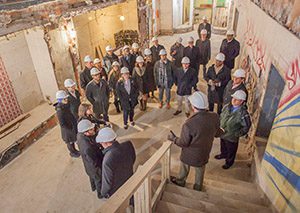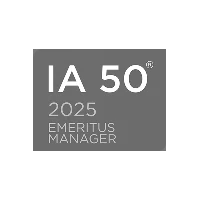By Danielle Graceffa, Senior Director, Legal Services
Real estate development has always been a risky proposition, fraught with numerous challenges that must always be carefully balanced against the promise of reward.
Throw in the possibility of rehabbing historic properties and that risk-reward scenario is certainly amplified. The city of Detroit, where we have our Midwestern office, is a perfect example.
Founded in the 1700s, the city has witnessed various transformations, with Henry Ford setting the stage for Detroit to become the booming manufacturing center that it is best known as. During that time, the population swelled from around 200,000 residents to well over 1.5 million. Fast forward to 2008 when Detroit, like many cities, suffered through a massive economic recession that ultimately required the city to file for bankruptcy. By that time, half of the local population had left the city, leaving behind thousands of beautiful, but vacant, homes and buildings that had been an integral part of the city’s history.
Typically, returning historic buildings to their former grandeur is a win-win for the city and its residents, especially now as we work to support Detroit’s revitalization. As a mission-driven lender, we are big advocates of this effort.
That is where the Federal Historic Preservation Tax Incentives Program, or what we normally call historic tax credits, comes into play.
Starting in 1976, the Federal tax code became aligned with national historic preservation policy to encourage voluntary, private sector investment in preserving historic buildings. It has since grown into one of the federal government’s most successful and cost-effective community revitalization programs.
Turning history into future reality
We’ve been fortunate to partner with a number of developers who have utilized this program to create great projects. Two in particular stand out:
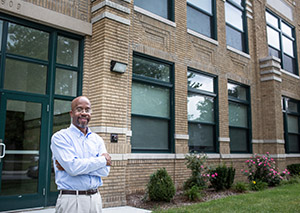
Richard Hosey stands in front of the now-renovated Kirby Center Lofts, providing affordable housing in Detroit.
Richard Hosey returned to Detroit in 2008 after nearly 15 years away from the city. Among his many projects was the former Tushiyah United Hebrew School in the Midtown neighborhood. Built in the 1920s to support the rising Jewish population, the building has served many purposes, including serving as the home for the first African-American Methodist Episcopal congregation in the city. Long abandoned and in poor shape, Richard saw promise in the building and transformed it into an affordable multi-family residential property in a mixed-income neighborhood.
Nearby, local developer Joel Landy has amassed 50 dilapidated properties over 20 years. While each one is a labor of love, it is the James Scott House that Joel is currently focused on.
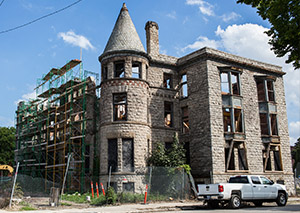
Funded in part by federal and state historic tax credits, James Scott House will help expand housing and opportunities in Midtown Detroit.
The castle-like Romanesque-style Scott House was built in 1897 by an individual Joel calls “gambler playboy” James Scott, who also financed the fountain on Belle Isle that bears his name. The original building was narrow; only 85 feet wide and 15 feet deep. Scott died soon after it was constructed and is believed never to have lived in it. When complete, it will become home to 27 new market-rate apartments and small-business retail.
How do federal historic tax credits work
On its face, it’s pretty simple. Current tax incentives for preservation include:
- 20% tax credit for the rehabilitation of certified income-producing (non-owner occupied) historic structures.
- 10% tax credit for the rehabilitation of non-historic, non-residential buildings built before 1936.
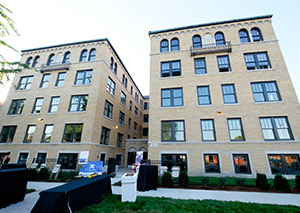
Detroit’s Rainier Court, supported by Capital Impact, was financed with federal historic tax credits.
The tax credits provide for a dollar-for-dollar reduction of federal income tax liability. The dollar value is calculated as a percentage of the qualified rehabilitation expenditures incurred during the course of the rehab construction. The reality of bringing these buildings back to life using this credit, however, can be complicated. Developers must go through a multi-step approval process, which is managed by the National Park Service and the State Historic Preservation Office. This includes determining the building’s eligibility for the credit, submitting a detailed rehabilitation plan, and proving that the work was performed to the Secretary of the Interior’s Standards for Rehabilitation.
Many developers also find that their incomes do not allow them to take full advantage of the historic tax credit. That’s where tax credit investors come in. Tax credit investors are typically banks, insurance companies and real estate investors who receive the tax credits as a pass-through in exchange for partnering with and providing capital to the project. Capital Impact Partners has collaborated with tax credit investors such as Enhanced Capital and InSite Capital.
Throw in the fact that you may have many lenders at the table to complete the financing package for the project, and developers quickly find working on a historic property is rarely a straightforward real estate deal! But the end-result for the developer and the people of Detroit is worth the effort.
Overcoming the challenges of financing historic renovations
Luckily, Capital Impact is one of the few Community Development Financial Institutions with an in-house legal team. Our expertise, combined with our personal interest in seeing the social impact of these projects, helps make these transactions run smoothly. In my role, I’m able to make sure all of the multiple parties and pieces are coordinated and moving in the same direction, including making sure that the various legal documents are consistent, with all agreements among the parties properly reflected within them.
Another particular challenge – though one I find particularly interesting – is the need for other credits or incentives at the local level in order to make the project financially feasible, such as real estate tax abatements or incentives. Utilizing these various credits and incentives requires engagement with political bodies as well as the various lenders and the tax credit investor. Working with city government requires a level of familiarity with city processes and personnel, and often means going through a public hearing process.
Many developers may also not realize that you can layer in other federal incentive programs to make projects financially viable. These include New Markets Tax Credits and the Low-Income Housing Tax credit, both of which are programs that Capital Impact has experience working with.
I’m sure not everyone would agree with me, but I think these types of deals are exciting and challenging. Every single deal has different aspects, unique issues, and to me, that’s more interesting than just straight-up, run-of-the-mill, easy loan deals where you’re not challenged to get it done. It just makes it interesting.
So, if you are a developer interested in renovating a historic property to create social impact anywhere in the country, my team is here to help. Please don’t hesitate to contact us.
[dcwsb inline=”true”]

